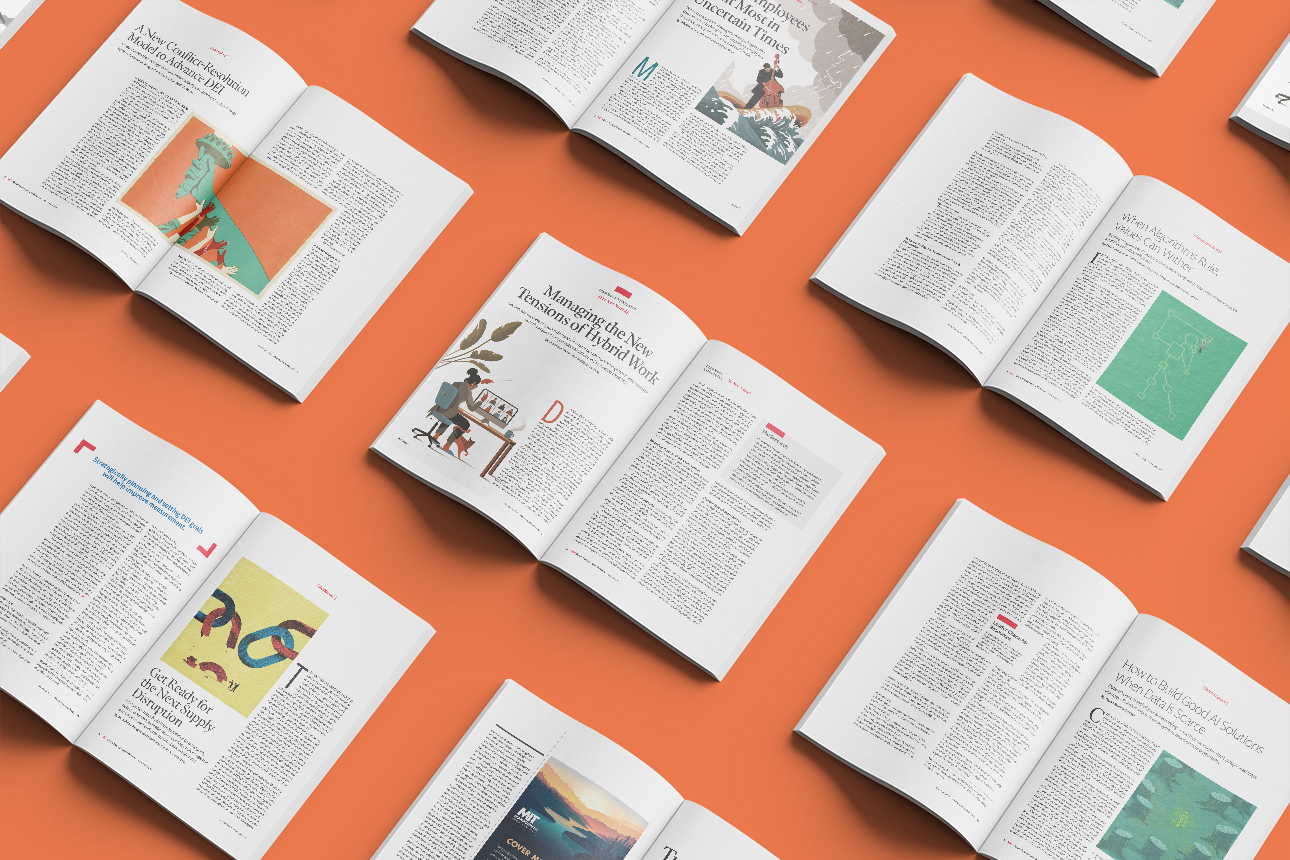Our Guide to the Winter 2023 Issue
These article summaries will help you navigate our winter 2023 lineup.
Topics

Turn Your Teams Inside Out
Deborah Ancona and Henrik Bresman
Key Insight: Externally focused teams can drive innovation, performance, and distributed leadership but require managers to move past their traditional focus on internal team dynamics.
Top Takeaways: Externally oriented teams have been shown to boost agility and speed of execution in the face of rapid change and uncertainty, but this approach can be difficult for organizations to adopt. Doing so requires managers to put aside assumptions that teams are bounded groups with stable membership and that the resources, information, and collaborators they need are only to be found inside the organization. Trying out this so-called x-team way of operating on a small scale is a strategy that can help change perspectives and build comfort with change.
What Employees Want Most in Uncertain Times
Kristine W. Powers and Jessica B.B. Diaz
Key Insight: During times of crisis, managers should prioritize individualized consideration and building trust to support employees.
Top Takeaways: When researchers asked employees what their supervisor could do to help alleviate the anxiety that arose from the pandemic, the data revealed that during a crisis, employees most want information about their job and the organization; psychological and instrumental support; and clear, fast, and accurate communication. The findings highlight the importance of individualized approaches, especially when employees want answers or resources that managers can’t realistically provide. Managers must also prioritize building trust.
Managing the New Tensions of Hybrid Work
Jonathan Trevor and Matthias Holweg
Key Insight: Large enterprises are accommodating employee demands for flexibility to work from home but are still working to manage the impact on culture and innovation.
Top Takeaways: As many employees resist the call to return to the workplace from the home offices they established during the pandemic, managers worried about losing talent are accommodating them but seeing signs of slowed innovation. The authors studied 20 global enterprises to gain insight into management concerns and emerging best practices for managing hybrid work effectively. They recommend setting policy based on the nature of the tasks performed, and bringing teams together for collaborative work and to strengthen social networks.
Make Leader Character Your Competitive Edge
Mary Crossan, William (Bill) Furlong, and Robert D. Austin
Key Insight: Fostering a culture where character is valued equally alongside competence can result in better decisions and better outcomes.
Top Takeaways: Leaders largely misunderstand the concept of character and think it’s just about ethics. But while strength of character certainly supports ethical decision-making, its reach is much broader. It exerts a powerful influence on both individual well-being and sustained excellence. Leader character also provides an accessible common language that weaves together the many different strategic agendas of the organization, whether it be risk management or diversity, equity, and inclusion.
How to Build Good AI Solutions When Data Is Scarce
Rama Ramakrishnan
Key Insight: The emergence of data-efficient AI techniques means that organizations don’t always need large volumes of labeled data to train AI systems based on neural networks.
Top Takeaways: Over the past few years, AI practitioners and researchers have made it possible to build accurate AI models with a fraction of the labeled data that might otherwise be needed. New techniques encompass ways to transfer models across related problems and to pretrain models with unlabeled data. These data-efficient techniques and best practices can help senior leaders who are championing the development and use of AI applications but running up against the challenge of insufficient labeled data.
Improve Your Diversity Measurement for Better Outcomes
Derek R. Avery, Enrica N. Ruggs, Larissa R. Garcia, Horatio D. Traylor, and Noelle London
Key Insight: In order for data analytics to provide a comprehensive view of diversity, equity, and inclusion (DEI) in an organization, managers must have a strategy for data collection designed to reveal how outcomes differ by demographics.
Top Takeaways: To advance DEI in their organizations, managers need more thoughtful and effective data collection practices that provide a more granular look at how outcomes vary for different groups, at different levels, and in different locations. Nike, IBM, and Salesforce, for instance, break out data on demographic representation based on leadership roles, tech roles, and nontech roles. Organizations must also integrate internal systems related to hiring, performance management, and other personnel records in order to better track outcomes for different groups.
Get Ready for the Next Supply Disruption
M. Johnny Rungtusanatham and David A. Johnston
Key Insight: Supply chain risks have become nearly incalculable. Managing them requires a capabilities-driven mindset.
Top Takeaways: Many companies were unprepared for the supply chain disruptions triggered by the COVID-19 pandemic, even though the threat of a global pandemic had been well known for nearly 20 years. Companies need a new mindset to prepare for the inevitable “black swan” triggers of the next supply challenge. To avoid catastrophic interruptions, companies need to build six specific capabilities to plan and respond: anticipate, diagnose, detect, activate resources for, protect against, and track all manner of threats.
When Algorithms Rule, Values Can Wither
Dirk Lindebaum, Vern Glaser, Christine Moser, and Mehreen Ashraf
Key Insight: Before rolling out algorithmic decision-making, leaders should adopt a responsible approach to AI that doesn’t focus exclusively on efficiency but considers the potential unintended human impact of their choices.
Top Takeaways: Organizations that aim to develop and deploy responsible AI systems must begin by considering what implicit and systemic biases reside in a technological system itself. There is a risk that, left unchecked, algorithmic systems can cause unintended organizational or social harm — such as when an Australian government program to recoup unemployment and disability benefits paid out to unqualified recipients ended up also demanding repayment from hundreds of thousands of people who had legitimately received the benefits. It is crucial for managers to understand that the solution to these kinds of technological failures is not better, or more, technology, but rather a better understanding of what implicit choices they are making when they use technology to solve a problem in the first place.
Now You See Me, Now I’m Gone
Boris Groysberg, Derek Haas, and Eric Lin
Key Insight: Employees at all performance levels have new ways to showcase their skills, making it more likely that not just stars but second-tier workers will be scouted by outside recruiters.
Top Takeaways: Digital collaboration tools are making employee contributions more visible within their organizations and connecting them with wider networks — which can provide them with more options for career growth elsewhere. The authors researched the effects of suddenly increased visibility in a specific labor market and found that it led to increased mobility. That means managers need to be paying attention to retaining not only their top performers but also their A-/B+ talent.
A New Conflict-Resolution Model to Advance DEI
Peter T. Coleman, Allegra Chen-Carrel, and Bodi M. Regan
Key Insight: Organizations that manage tensions constructively can create and sustain change.
Top Takeaways: Diversity, equity, and inclusion initiatives that promote social justice in organizations necessarily boost tensions: They make inequities visible and make many people — especially those from dominant groups — uncomfortable. When workplaces respond to such tensions by simply tamping down conflict, they miss opportunities to solve systemic problems. The authors draw on their work in conflict resolution to create a set of strategies for fostering lasting change. They advise managers to capitalize on crisis events, thoroughly map the landscape to understand the concerns and positions of all stakeholders, identify and deconstruct destructive dynamics, bolster constructive dynamics, and create systems for accountability.




